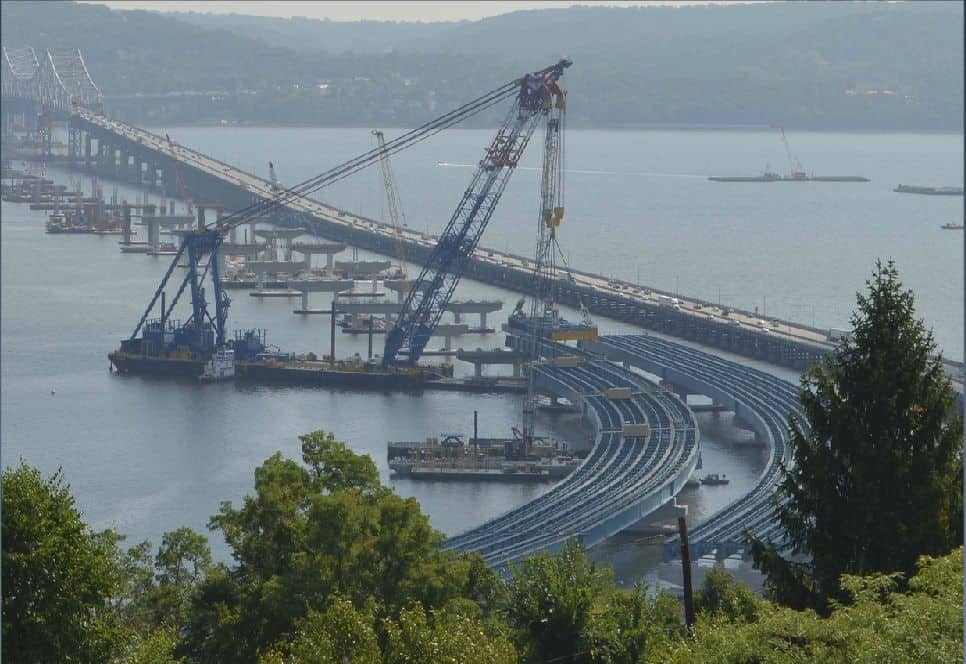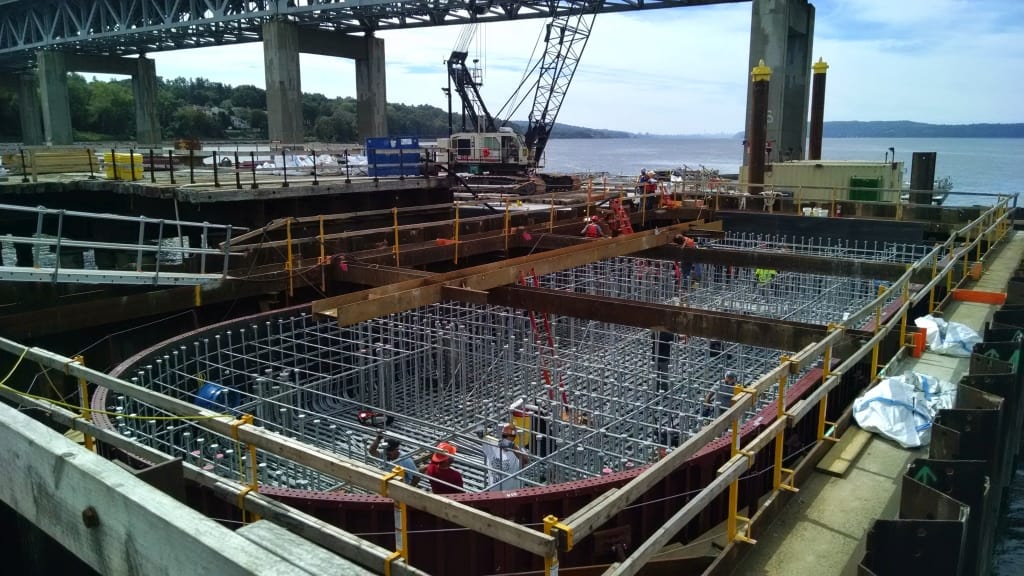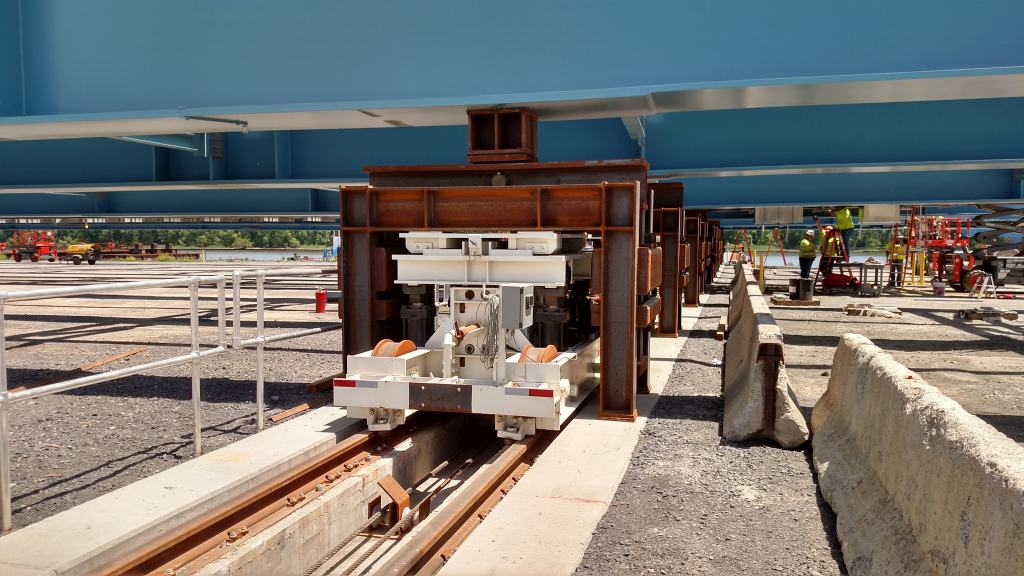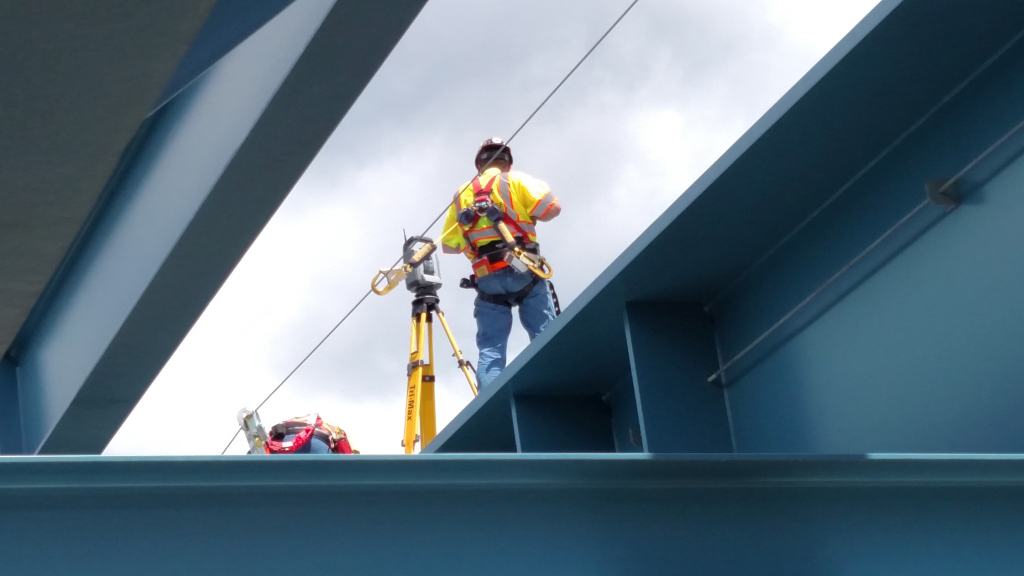Took in a structural engineering education conference on Thursday. PDH's to the rescue at renewal time!!!!!
First speaker was a professor at University of San Diego who does tons of research on how to design structural members for optimal results when earthquakes occur. They build some huge test structures with numerous hydraulic cylinders and such to put large structural composite beams, etc. through the equivalent of predicted forces brought on by earthquakes. They really know how to wreck some massive systems. Decided this must be part of the reason why engineering students take so many classes in physics, far out differential equations and properties of materials. No cookbooks and handbooks for that kind of work. Very interesting presentation.
The second speaker works for HDR and is part of a huge team effort to build the two 3.1-mile long bridge systems across the Hudson River to replace the Tappan Zee bridges. Nearly 4 billion dollars worth of project. Have had 35 of the world's largest cranes onsite at the same time. Some piles are around 400 feet long and 6-feet in diameter. Many of the piles are friction piles because it is up to 650 feet to solid rock for a major part of the crossing. The twin systems are designed to allow the installation at some later date of a light rail line between them. Traffic flow on the existing bridges are around 140,000 per day so a key part of the plan is how to build and make connections without interrupting things very much at all. The pier tubs for the primary bridges are longer than a football field including both end zones and about 60 yards wide. Almost everything except the columns is constructed offsite, thus the need for the huge cranes.
Another speaker was focused on the local project to finally construct a city bypass that has taken 52 years to make it to the completion phase. Politics, politics and environmental debate followed by more of the same for decades. I drove past the western end and noted three total stations set up within a 75-foot radius. Northbound traffic is the pits during the final connection phase as everyone moves into a single lane for about 800 feet.
I don't get out much, particularly out of Oklahoma...save a few trips to Colorado and Wisconsin to visit kin..so I had to look up this Tappan Zee fiasco you mentioned. What a mess.
This article kind of puts it in a nutshell.
Sheez. And I thought Oklahoma and Texas had a hard time getting along.
Holy Cow, post: 360788, member: 50 wrote: Took in a structural engineering education conference on Thursday. PDH's to the rescue at renewal time!!!!!
build the two 3.1-mile long bridge systems across the Hudson River to replace the Tappan Zee bridges. Nearly 4 billion dollars worth of project. Have had 35 of the world's largest cranes onsite at the same time. Some piles are around 400 feet long and 6-feet in diameter. Many of the piles are friction piles because it is up to 650 feet to solid rock for a major part of the crossing. The twin systems are designed to allow the installation at some later date of a light rail line between them. Traffic flow on the existing bridges are around 140,000 per day so a key part of the plan is how to build and make connections without interrupting things very much at all. The pier tubs for the primary bridges are longer than a football field including both end zones and about 60 yards wide. Almost everything except the columns is constructed offsite, thus the need for the huge cranes.
Been there done that. The bearings look like large rubber air bags from a big rig, except they are 3ft in diameter.
Holy Cow, post: 360788, member: 50 wrote: Took in a structural engineering education conference on Thursday. PDH's to the rescue at renewal time!!!!!
First speaker was a professor at University of San Diego who does tons of research on how to design structural members for optimal results when earthquakes occur. They build some huge test structures with numerous hydraulic cylinders and such to put large structural composite beams, etc. through the equivalent of predicted forces brought on by earthquakes. They really know how to wreck some massive systems. Decided this must be part of the reason why engineering students take so many classes in physics, far out differential equations and properties of materials. No cookbooks and handbooks for that kind of work. Very interesting presentation.
The second speaker works for HDR and is part of a huge team effort to build the two 3.1-mile long bridge systems across the Hudson River to replace the Tappan Zee bridges. Nearly 4 billion dollars worth of project. Have had 35 of the world's largest cranes onsite at the same time. Some piles are around 400 feet long and 6-feet in diameter. Many of the piles are friction piles because it is up to 650 feet to solid rock for a major part of the crossing. The twin systems are designed to allow the installation at some later date of a light rail line between them. Traffic flow on the existing bridges are around 140,000 per day so a key part of the plan is how to build and make connections without interrupting things very much at all. The pier tubs for the primary bridges are longer than a football field including both end zones and about 60 yards wide. Almost everything except the columns is constructed offsite, thus the need for the huge cranes.
Another speaker was focused on the local project to finally construct a city bypass that has taken 52 years to make it to the completion phase. Politics, politics and environmental debate followed by more of the same for decades. I drove past the western end and noted three total stations set up within a 75-foot radius. Northbound traffic is the pits during the final connection phase as everyone moves into a single lane for about 800 feet.
Certainly useful in your practice. Same here, to get the hours I need to branch out into areas I never dreamed of!
Attending such diverse programming does more to wake up a sleepy ol' geezer than attending programming that is a rehash of the rehash of the rehash that you have witnessed every year for the past ten years. The earthquake program took me back through the decades to those godawful years of listening to math professors who had no experience with applying anything they taught. They could parrot what all the math books contained but had no clue as to reality. If only they would allow those who work in the real world to be the instructors far more students would pay attention. It wasn't until a junior professor in electrical engineering lit a spark in me during my senior year that I really got a grasp of the upper half of my calculus training. Suddenly, those fuzzy concepts became crystal clear. It reminded me of high school Latin class (Junior year to boot) where I first learned English. The English teachers hadn't accomplished that despite marking A's in my grade book.
Squire HC-
As I'm a "non Calculser", could you take a bit of your time to lead me to where a cadastral surveyor would use calculus for a hands on application ?
Cheers,
Derek
Google the book Foundations of Differential Geodesy by Joseph Zund as a start.
Everything changes constantly but at varying rates. The Earth rotates. The Earth wobbles. Continental plates drift. Satellites are not perfectly geosynchronous. Everything electronic has quirks. The ground moves up and down during freeze/thaw and drouth/fully saturated shifts. In some places hillsides move. In some places earthquakes alter the scenery. Some places subside at varying rates. Algorithms are approximations. And so forth and so on. Calculus is all about change.
Normal people work with norms and fixed assumptions every day. Calculus is the tool to address everything else that makes the clear fuzzy.
We use common tools to make common decisions. Sometimes exceptional tools are required for exceptional circumstances. Imagine being at a large sports venue, such as the Super Bowl. Before anyone arrives, the structure is more or less static. As the crowd begins to assemble, the dead weight of the body masses begin to place loading on the structural members in different amounts in differing locations as time passes until everyone has arrived. Their very footfalls induce non-rhythmic dynamic loading throughout the structure. As emotions grow and subside, sometimes incredible dynamic loading occurs as one like-thinking group grows boisterous and leaps about while a different like-thinking group grows somber and subdued. Natural forces of ambient temperature, wind and solar input places varying stresses on the structural members. Halftime arrives and the masses exit their seats, move via numerous pathways to the restrooms and food venues and return. Huge quantities of water flow through the pipes and sewers every minute. Eventually, everyone leaves but the cleanup crew.
Somewhere, somebody (actually a collection of somebodies) conducted all sorts of tests to determine each potential differential loading relative to the combination of structural members. Putting all 397, 000 different scenarios through multiple regressions for their unique responses while holding the other 396,999 as fixed results in approximations. Cycling all the various permutations through hundreds of thousands of iterations produces a single range of potentials. Loading calculations are prepared and run using time-honored magic equations. The bean counters are called in to determine the maximum cost of construction allowed. The designers shoot for a target that will comply with the cost constraints and the critical loading while artistically offering a pleasant environment within the venue. Calculus runs rampant.
"Hell fer stout" is no longer an option like it was for the pioneers as they advanced across the land constructing the first improvements. Neither is rounding everything to the nearest rod.
I have never use calculus in any surveying application.
It has been so long since I've applied calculus to anything that it has left my memory banks to make room for more important stuff.
That is a math for statistics, mortality tables, variable research and to guess what the probability of snow falling in July around Austin, Texas.
The only thing I have learned from calculus is that when lowballers operate and charge $800 to survey a 10ac title survey, it hurts every surveyor.
0.02
I think it was a calculus class...
Anyway, I remember a test question that had to do with a spherical storage tank. The tank had outlets at certain intervals up its exterior. The questions had to do with time intervals during filling the tank with liquid when each outlet would be reached...
I didn't do well on the test.
Thankfully that question wasn't on the LS exam....:whistle:
If I remember correctly derivatives were part of my Calc I and Calc II class. The only part of surveying that I know is part of calculus has to do with a parabolic curve or vertical curve. The derivative is the constant rate of change, where this equals zero is the high or low point of the curve.
Sounds like Lee Green has been on the bridge project. Anyone else working on something similar?
I fought with Calculus all through high school
Even took it at first year university
But it was only in my fourth year of Survey School that it finally made any sense - for calculation of observation error elipses
I guess star-net or tbc does that for you these days
The first couple of semesters aren't unbearable like the third and fourth semesters.
It's a bit like mastering a foreign language. If you stumble through the first two classes any others remaining will kill you.







